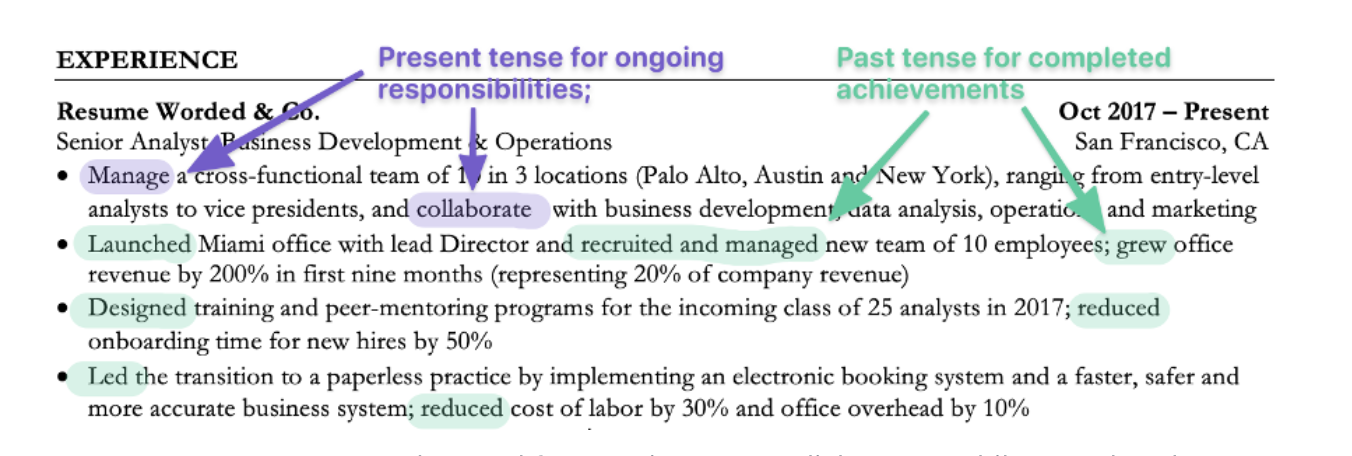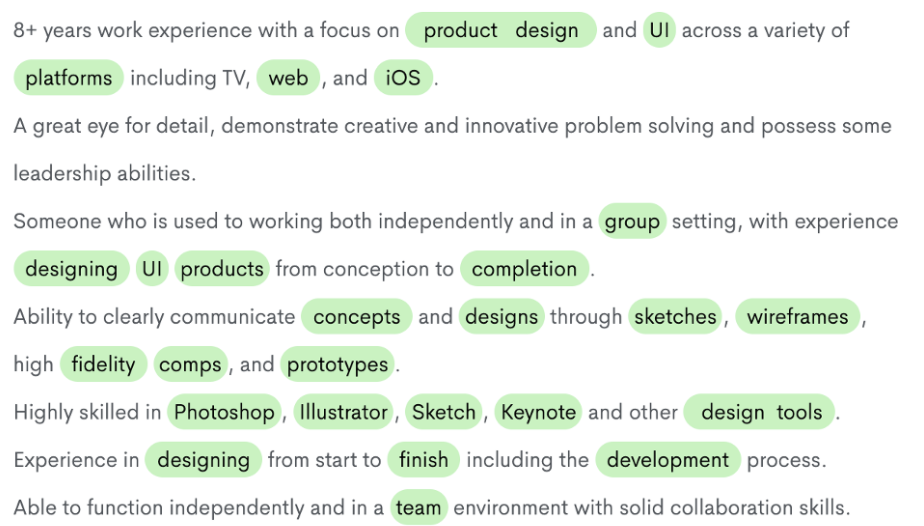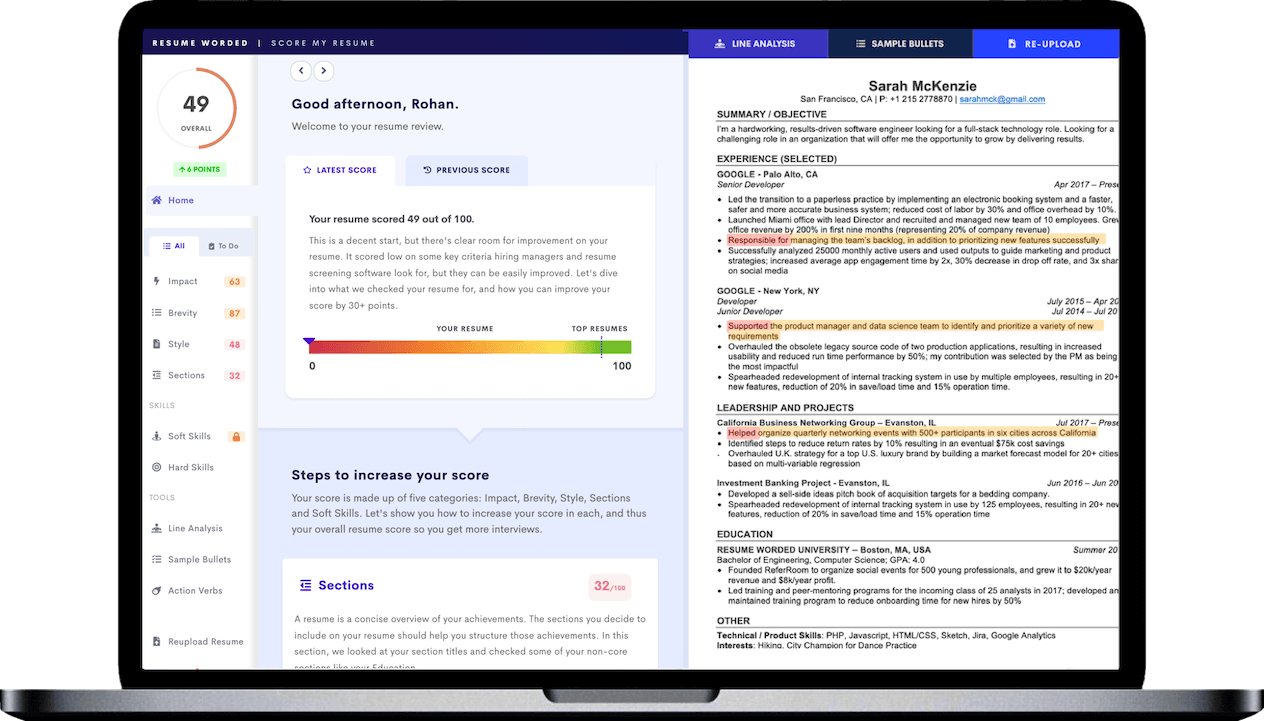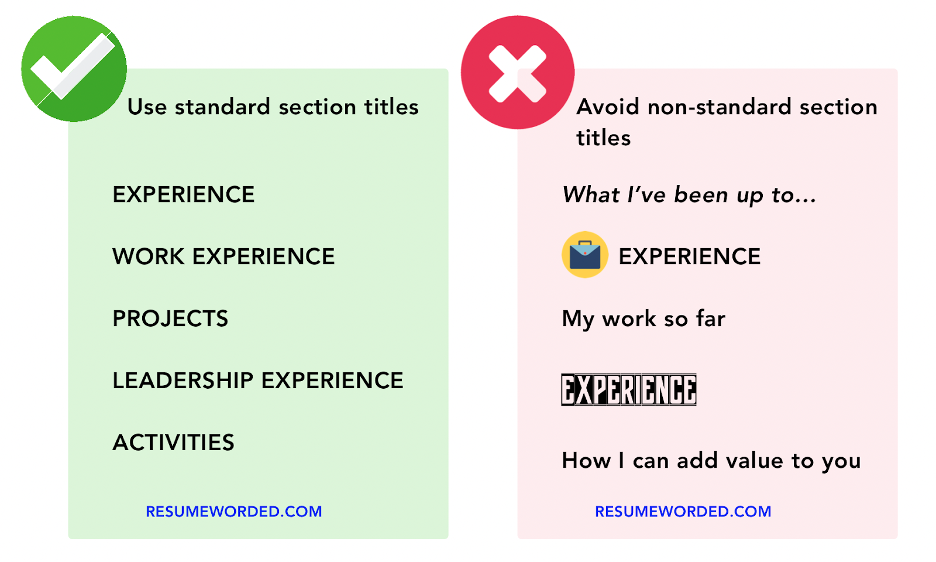When writing your resume, sometimes it's the little details that matter the most — like whether to write in past or present tense. Both are valid choices; past tense makes sense when discussing your accomplishments, while present tense sounds fresh and immediate. So, which one to choose?
The quick answer is you should always use past tense on your resume. This ensures you're focussing on accomplishments rather than responsibilities and is what most modern recruiters expect to see.
In this article, we'll discuss how to decide what tense to use on your resume, provide examples of how and when to use the correct tense, and discuss how using the proper tense can boost your resume's readability and ATS compatibility.
Should your resume be in present or past tense?
There's actually an easy answer to this one — resumes should be written in past tense.
Why? Your resume should be about your accomplishments, not your responsibilities. In other words, you should write about things you've already achieved, not what you’re currently working on, ergo: past tense!
The biggest mistake people make on their resumes is listing job duties rather than accomplishments. Using the present tense in your bullet points is a good indicator that you're focusing on responsibilities rather than accomplishments.
Examples of present tense resume statements:
- Manage a team of 10 people...
- Organize annual fundraising events...
Examples of past tense resume statements:
- Designed training and peer mentoring programs...
- Led the transition to a paperless practice...
When to use past tense on a resume
In general, using past tense is always correct. This applies even to your current job.
You should use past tense for your current job when listing accomplishments, such as completed projects or skills, and when quantifying your experience to show the result of your work. When listing achievements that are currently ongoing, you can still use the past tense, if you prefer, to maintain consistency throughout your resume.
When talking about past positions you’ve held, always use past tense. Never use present tense for a job you’re no longer at. At worst, this could cause recruiters to reject your application because it shows a lack of attention to detail — so don’t risk it when it’s an easy thing to get right.
When to use present tense on a resume
When talking about your current position, you're likely to have accomplishments that are still ongoing. This might include:
- General day-to-day responsibilities
- Ongoing projects that haven't wrapped up yet
In this case, it's appropriate to write in the present tense on your resume when discussing your current job. For example, if you're currently mentoring interns or collaborating with other teams, it's acceptable to write that in the present tense.
This means that, regardless of what you were taught in high school English, it's okay to mix tenses on your resume when writing about your current job. Just make sure you're doing it intentionally, to clearly distinguish between your ongoing responsibilities and your past accomplishments.
A good way to check if you’ve used the right verb tense on your resume is to upload your resume to the tool below — it’ll let you know if you have shown accomplishments and responsibilities the right way by analyzing each of your tenses. It’ll also identify any grammatical and spelling errors and give you suggestions for improvements.
How verb tense affects the readability of your resume
Your resume is often the first impression you make on potential employers. Using the correct verb tense not only demonstrates your attention to detail but also makes your resume easier to read.
Using past tense for previous roles and accomplishments creates a clear, chronological flow for anyone reading your resume, helping recruiters quickly understand the progression of your career. Using the present tense for ongoing duties distinguishes your current responsibilities from past achievements, making it easier to see which roles and projects you’re still involved in and which are completed.
The key is to be consistent. Flipping randomly between tenses can confuse a recruiter trying to skim your experience and pick out your relevant skills. Using consistent verb tense on your resume (past for previous jobs, present for the current job) ensures the important information is easy for a recruiter to understand and, therefore, offers you the best chance of making a good impression.
How resume verb tense affects ATS
Modern companies often use Applicant Tracking Systems (ATS) to filter job applications based on predetermined keyword criteria. ATS can be very sensitive to how information is presented on your resume, including verb tense.
For example, if the ATS software is looking for specific words, such as “taught” or “managed” on your resume, and you’ve written these in the present tense, as “teach” and “manage”, the software might not register this as relevant experience, and flag your resume as not including the right keywords.
To safeguard against this problem, if a job listing emphasizes past achievements, use past tense to ensure you capture those particular keywords, and only use resume present tense for roles that emphasize ongoing responsibilities.
Examples of using the right tense on a resume
Curious about what past vs present tense looks like in action? Here are some examples that you can follow.
Using past tense on a resume
Use the past tense on a resume for any accomplishments that you've already completed and all past jobs, for example:
- Launched Miami office with lead Director and recruited and managed new team of 10 employees; grew office revenue by 200% in first nine months (representing 20% of company revenue).
- Designed training and peer-mentoring programs for the incoming class of 25 analysts in 2017; reduced onboarding time for new hires by 50%.
- Led the transition to a paperless practice by implementing an electronic booking system and a faster, safer, and more accurate business system; reduced cost of labor by 30% and office overhead by 10%
- Created a unique year-round adopt-a-school recruitment program which grew market share from 5% to 10%.
- Directed agency fundraising revenue generation, daily program business operations, community outreach membership recruitment, and human resources in 30 suburbs in the city for organizations with assets of $8M.
- Served as the product sale fundraising campaign manager and directed 100 volunteer chairpersons; increased fundraising donations by 40%.
- Negotiated a settlement of a $2M lawsuit with under $5,000 of outside legal fees.
- Increased customer retention 10% and reactivated dormant consumers through weekly email campaigns.
- Took lead on the migration of the company's Microsoft SQL to MySQL project. This included updating 30 client-facing websites and one internal administration site
- Promoted within 18 months due to strong performance and organizational impact (one year ahead of schedule).
Using present tense on a resume
Use the present tense on your resume for accomplishments that are still ongoing at your current job, for example:
- Manage a cross-functional team of in 3 locations (Palo Alto, Austin, and New York), ranging from entry-level analysts to vice presidents, and collaborate with business development data analysis, operations, and marketing.
- Manage all aspects of a 10 person B2B appointment setting call center.
- Provide administrative support and guidance to the CEO in day-to-day office operations.
- Oversee a $7M budget and fifteen-member team.
- Lead team members and vendors to manage the social media advertising strategy for more than 50 social media accounts
- Train and mentor new and existing account executives and interns on solutions selling strategies, customer relationship management, and advanced product knowledge.
- Supervise a team of 15 associates in addition to overseeing a staff of 60+ associates while managingdaily operations of the store.
- Service and manage 150+ target accounts consisting of medical doctors, chiropractors, acupuncturists, nurses, dieticians, and nutritionists
- Direct and coordinate a staff of 80 employees.
- Manage a team of 15 outbound sales specialists.
Are there any exceptions?
Yes! There are a few times it’s okay to use present tense in your resume instead of past tense.
Ongoing accomplishments
Some accomplishments may make more sense written in present tense. This doesn’t mean you should write every bullet point from your current job in present tense, but you might include the occasional accomplishment that’s still ongoing. A good example is leading a team — if you’re currently managing other staff, it’s fine to write your bullet point as “manage a team of 5” instead of “managed.” If you don’t like the idea of writing some bullet points in past tense and some in present tense, it’s also fine to write everything in past tense, even if you’re currently in the same position.
Resume summary
Your resume summary is another section where it’s fine to write in present tense. This also applies to a short (1-2 sentence) blurb you might include as a quick overview of your current job — overviews of past jobs should be written in past tense.
Cover letter
A lot of resume “rules” — like writing in past tense or not using “I” statements — don’t apply to cover letters. It’s fine to write your cover letter more conversationally than the rest of your resume, which means you can write in present tense about things you’re currently doing.
How to use action verbs in the past tense
Using powerful action verbs on your resume helps demonstrate your accomplishments in a memorable way, highlighting the effectiveness of your previous roles. Action verbs are most commonly used in the past tense, as they describe your past successes and the positive results of your past work.
Strategically using action verbs in the past tense, combined with specific examples and quantified metrics, can make your resume more engaging, memorable, and persuasive.
Selecting the right action verbs
The key is to choose verbs that describe your experience and achievements. Here's a list of powerful action verbs categorized by the type of achievement:
- Leadership and management: Led, Managed, Directed, Supervised, Coordinated
- Innovation and creativity: Developed, Designed, Innovated, Created, Pioneered
- Problem-solving: Resolved, Streamlined, Improved, Overhauled, Reconciled
- Sales and revenue growth: Increased, Amplified, Boosted, Generated, Accelerated
- Project management: Executed, Completed, Achieved, Realized, Accomplished
- Customer service: Enhanced, Delivered, Served, Supported, Assisted
When incorporating these verbs into your resume, focus on quantified results to show the impact of your actions. For example:
- Instead of saying, "Was responsible for managing a team," say, "Managed a team of 10, enhancing productivity by 30%."
- Replace "Worked on project management" with "Executed a complex project within deadline, achieving a 15% cost saving."
Common mistakes to avoid with resume verb tense
Make sure to avoid these common mistakes when deciding what tense to use on your resume.
- Mixing tenses in the same bullet point: While you can use both past and present tense to describe your current job, avoid mixing tenses within the same bullet point, as this can make your statements difficult to follow.
- Overuse of present tense: Using present tense for past positions can confuse recruiters about your employment history. Stick to past tense for all roles you're no longer engaged in, and only use present tense on your resume for your current position.
- Neglecting completed projects: When describing completed projects in current roles, use past tense to emphasize the accomplishment and its impact.
- Using present participles (gerunds): Using verbs that end in -ing, like "managing a team" or "organizing events", is less impactful and can read more like job descriptions than achievements. Opt for simple past tense ("managed a team"), and simple present tense ("manage a team") for current roles. These phrases are more direct and convey a sense of completion or active engagement.
What other grammar rules do I need to know to write a resume?
Keep it simple
Always write in simple past or present tense — analyzed, led, increased, manage. Never use the present participle form (eg. analyzing, leading, managing). Saying that you “manage a team” or “managed a team” is fine, but listing “managing a team” reads like a job description, not an accomplishment.
Passive vs active voice
You may have heard the advice to always use active voice, but what does that mean? Active voice is when you talk about things you did, e.g. "increased sales" or "trained new staff." Passive voice is when you talk about something that was done to you, e.g. "was asked to organize an event," or "tasked with training new staff." Active voice is always better — it's more straightforward, easier to read, and keeps the focus squarely on what you actually accomplished rather than just what you were asked to do.
(Im)perfect tense
Perfect tense is another thing to avoid on your resume. Perfect tense is when you add "have" or "had" to indicate that you've done something, e.g. "I have increased sales" or "I had organized 10 events." Leave out empty verbs like "have" and "had," which add nothing to your resume except hard-to-read filler.
First or third person: what's better on a resume?
The other thing to consider when writing your resume is point of view. Resumes are written in first person since you’re talking about yourself and your own accomplishments. This means your bullet points should sound like they were written by you. For example, if you’re talking about leading a team, you should write that you “managed” a team (or “manage,” if it’s your current position). Don’t write “manages a team” as if your resume is being written by somebody else.
You also shouldn’t use “I” statements outside of your cover letter, eg. “I manage a team.” Your resume is a formal document, so leave the “I” out of it.
Related: Improve Your Resume by Eliminating Adverbs
If you’re not sure what tense to use...
If you aren’t certain whether you should list something in past or present tense, always default to past tense. Even in cases where present tense may be more appropriate, past tense is never wrong and is unlikely to look strange to a hiring manager. Using present tense incorrectly, on the other hand, may raise a few red flags.










